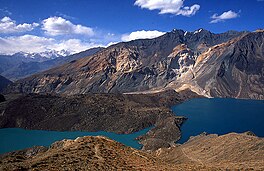| Sarez Lake | |
|---|---|
 Usoi Dam separating Sarez (right) and Shadau (left) lakes Usoi Dam separating Sarez (right) and Shadau (left) lakes | |
 | |
| Coordinates | 38°12′06″N 72°45′27″E / 38.20167°N 72.75750°E / 38.20167; 72.75750 |
| Primary inflows | Murghab River |
| Primary outflows | Murghab River |
| Basin countries | Tajikistan |
| Max. length | 75.8 kilometres (47.1 mi) |
| Max. width | 3.3 kilometres (2.1 mi) |
| Surface area | 79.7 square kilometres (30.8 sq mi) |
| Average depth | 201.8 metres (662 ft) |
| Max. depth | 505 metres (1,657 ft) |
| Water volume | 16.074 cubic kilometres (3.856 cu mi) |
| Shore length | 162 kilometres (101 mi) |
| Surface elevation | 3,263 metres (10,705 ft) |
| Shore length is not a well-defined measure. | |

Sarez Lake (/səˈrɛz/ sə-REZ) is a lake in Rushon District of Gorno-Badakhshan province, Tajikistan. Its length is about 75.8 kilometres (47.1 mi), its depth about a few hundred meters, its water surface elevation about 3,263 metres (10,705 ft) above sea level, and volume of water over 16 cubic kilometres (3.8 cu mi). The mountains around it rise over 2,300 metres (7,500 ft) above the lake level.
The lake formed in 1911, after a great earthquake, when the Murghab River was blocked by a big landslide. Scientists believe that the landslide dam formed by the earthquake, known as the Usoi Dam, is unstable given local seismicity, and that the terrain below the lake is in danger of catastrophic flood if the dam were to fail during a future earthquake. The Usoi Dam wall survived a localised 7.2 magnitude earthquake, the 2015 Tajikistan earthquake, on the 7th December 2015 with no visible signs of deterioration.
Shadau Lake is a small water body southwest of the Usoi Dam and west of Sarez Lake.
Formation
The formation of Sarez Lake is described in the book by Middleton and Thomas:
The 1911 Sarez earthquake, estimated at 6.5-7.0 on the Richter scale, occurred about midnight, 5–6 February 1911 (old style). Deaths were estimated at 302. The landslide was 2.2 billion cubic meters and formed the Usoi Dam which is approx. 5 kilometres (3.1 mi) long, 3.2 kilometres (2.0 mi) wide and up to 567 metres (1,860 ft) high, the tallest natural dam in the world. Usoi was a village buried under the landslide. The area was so isolated and the destruction of mountain tracks so complete that it took six weeks before word reached the Russian posts at Murghab and Khorog.
In 1968 a landslide caused two-meter-high waves in the lake. A 1997 conference in Dushanbe concluded that the dam was unstable and might collapse if there were another powerful earthquake. A 2004 study by the World Bank held that the dam was stable. The principal danger seems to be a partially detached mass of rock of about 3 cubic kilometres that could break loose and fall into the lake. Since the valley below the dam is so narrow, any flood would be very destructive. The result of a global risk analysis carried out by STUCKY for the World Bank was presented at the 2002 IAHR Symposium in St Petersburg and at the 2006 International Congress on Large Dams in Barcelona.
Notes
- Tajik: Сарез кӯл, romanized: Sarez ko‘l, IPA: [sɐˈɾes‿kʰɵl]; Russian: Сарезское озеро, romanized: Sarezskoje ozero, IPA: [sɐˈrʲesːkəje ˈozʲɪrə]
References
- Bolt, B.A., W.L. Horn, G.A. Macdonald and R.F. Scott, (1975) Geological hazards: earthquakes, tsunamis, volcanoes, avalanches, landslides, floods Springer-Verlag, New York, ISBN 0-387-06948-8
- "Shadau Lake on 1:110'000 map" (JPG).
- Robert Middleton and Huw Thomas, Tajikistan and the High Pamirs, Odyssey, 2008, ISBN 962-217-773-5, ISBN 978-962-217-773-4
- http://lmswww.epfl.ch/Common_Documents/Amis_LMS+R/Article_P.droz_IAHR-Sarez%20Article2.pdf
- http://www.stucky.ch/en/contenu/pdf/c_5_1.pdf
External links
- Map of the Usoi Dam - Sarez Lake, Scale 1:110'000
- NASA Earth Observatory photo
- Sarez Risk Mitigation Project Archived 2011-12-07 at the Wayback Machine
- Sarez lake, Rogun HPP, Aral sea ... Archived 2013-03-05 at the Wayback Machine